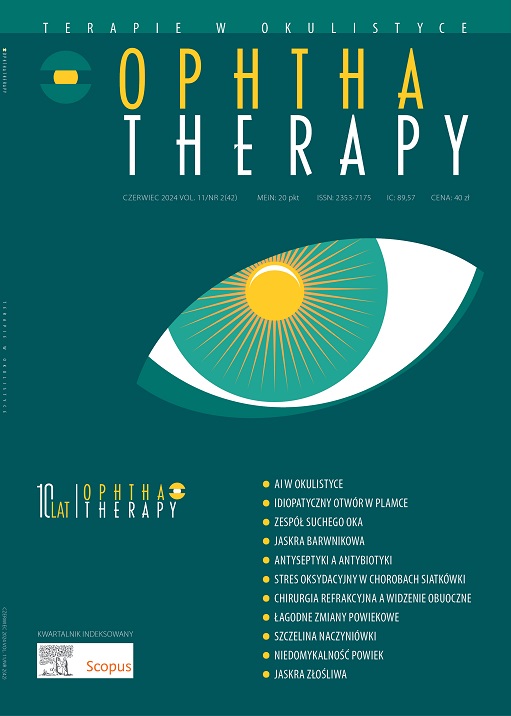Pigmentary glaucoma - a case report Case report
Main Article Content
Abstract
Pigmentary glaucoma is a type of secondary open-angle glaucoma. Mainly it is a consequence of pigment dispersion syndrome, which is characterized by pigment accumulation in the anterior segment of the eye. Pigment in the trabecular meshwork can cause increased intraocular pressure leading to glaucomatous damage of the optic nerve. We present a case of 40-year-old myopic male with typical symptoms of pigmentary dispersion syndrome who received late diagnosis of the disease. The correct diagnosis of pigmentary dispersion syndrome is crucial in preventing glaucomatous vision impairment.
Downloads
Article Details
Copyright: © Medical Education sp. z o.o. License allowing third parties to copy and redistribute the material in any medium or format and to remix, transform, and build upon the material, provided the original work is properly cited and states its license.
Address reprint requests to: Medical Education, Marcin Kuźma (marcin.kuzma@mededu.pl)
References
2. Wasyluk J, Prost ME. Pigment dispersion syndrome and pigmentary glaucoma. Contemporary diagnostics and therapeutic approach. Ophthatherapy 2014; 1(1): 35-40.
3. Niyadurupola N, Broadway DC. Pigment dispersion syndrome and pigmentary glaucoma - a major review. Clin Exp Ophthalmol. 2008; 36(9): 868-82. http://doi.org/10.1111/j.1442-9071.2009.01920.x.
4. Sivaraman KR, Patel CG, Vajaranant TS et al. Secondary pigmentary glaucoma in patients with underlying primary pigment dispersion syndrome. Clin Ophthalmol. 2013; 7: 561-6. http://doi.org/10.2147/OPTH.S42456.
5. Fornes AM. Pigment dispersion syndrome: The reverse pupillary block theory and new treatment options. Clin Eye Vis Care. 1995; 7(4): 229-31. https://doi.org/10.1016/0953-4431(95)00141-7.
6. Zeppieri M. Pigment dispersion syndrome: A brief overview. J Clin Transl Res. 2022; 8(5): 344-50.
7. Noecker RJ. Pigment Dispersion Syndrome and Pigmentary Glaucoma. In: Noecker RJ (ed.). Glaucoma Medical Therapy: Principles and Management. Springer, 2008.
8. Zeppieri M, Tripathy K. Pigment Dispersion Glaucoma. In: StatPearls Internet. Treasure Island (FL): StatPearls Publishing, 2023.
9. Siddiqui Y, Ten Hulzen RD, Cameron JD et al. What is the risk of developing pigmentary glaucoma from pigment dispersion syndrome? Am J Ophthalmol. 2003; 135(6): 794-9. http://doi.org/10.1016/s0002-9394(02)02289-4.
10. Buffault J, Leray B, Bouillot A et al. Role of laser peripheral iridotomy in pigmentary glaucoma and pigment dispersion syndrome: A review of the literature. Journal francais d'ophtalmologie. 2017; 40(9): e315-21. https://doi.org/10.1016/j.jfo.2017.09.002.
11. Okafor K, Vinod K, Gedde SJ. Update on pigment dispersion syndrome and pigmentary glaucoma. Curr Opin Ophthalmol. 2017; 28(2): 154-60. https://doi.org/10.1097/icu.0000000000000352.
12. European Glaucoma Society Terminology and Guidelines for Glaucoma, 5th Edition. Br J Ophthalmol. 2021; 105(Suppl. 1): 1-169. https://doi.org/10.1136/bjophthalmol-2021-egsguidelines.
13. Liput J, Tan W. Selective laser trabeculoplasty for open angle glaucoma. Opththatherapy. 2017; 4(4): 199-209.
14. Ayala M, Chen E. Long-Term Outcomes of Selective Laser Trabeculoplasty (SLT) Treatment. Open Ophthalmol J. 2011; 5: 32-4. https://doi.org/10.2174/1874364101105010032.
15. Brusini, P, Papa V. Canaloplasty in Pigmentary Glaucoma: Long-Term Outcomes and Proposal of a New Hypothesis on Its Intraocular Pressure Lowering Mechanism. J Clin Med. 2020; 9(12): 4024. https://doi.org/10.3390/jcm9124024.

